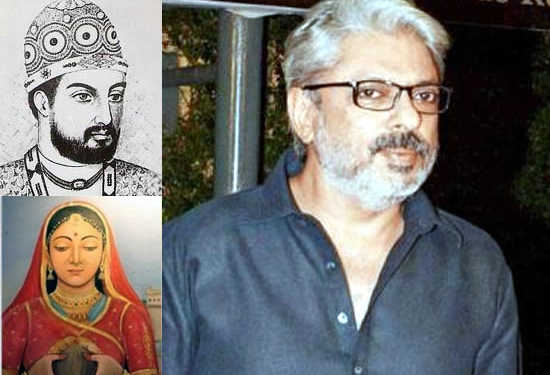Sanjay Leela Bhansali decided to direct period dramas after almost two decades of romantic filmmaking. His first period film Bajirao Mastani (2015) was mired in controversies. The Marathi Community registered their dissatisfaction at the inaccurate portrayal of a Key Maratha historical figure in the movie. They protested, but nonviolently and with restraint. Definitely emboldened by the fact that his inaccuracies were not effectively checked, he went ahead with another attempt – a gigantic misrepresentation of History.
Sanjay Leela Bhansali concocted a storyline according to ‘his interpretation of history’, In which, a Delhi Sultan from the Khilji Dynasty, Alauddin Khilji has a romantic interest in a Rajput Queen, Rani Padmini.
Now let us view the controversy with different angles to get the right perspective:
- Who was Rani Padmini?
- Was Khilji’s infatuation with the Rani a romantic interest or pure lust?
- Was Sanjay Leela Bhansali depicting the right history or was he depicting a distortion?
Who was Rani Padmini?
Alauddin Khilji was basically famous for 3 things. Firstly for repelling repeated attacks from the powerful Mughals who eyed Delhi. Secondly for was his daring and repeated forays into the South which was ruled by stronger rulers, like the Warangal (Telangana) based Kakatiyas and Hampi based Vijayanagara Empire. Third reason was his connection with the Jauhar (self-immolation) episode of a string of Rajputana Women which included the queens of Chitor after his conquest of Chitor. His pretext of invading Chitor was his infatuation and lust for the second Queen of Chitor, Rani Padmini and wife of King Ratan Rawal Singh.
Other than that, the legacy of Alauddin Khilji as a tyrant would make even the legacy of the Mughal Badshah Aurangzeb look like a peaceful realm.
Was Alauddin’s interest a ‘Romantic Interest’ or was it purely lustful?
It would be interesting to note that, many of the Delhi Sultanate Sultans and Mughal Badshahs had acquired Hindu wives after marrying daughters of Hindu Kings, on request or after a conquest. At least 3 Sultans of the Delhi Sultanate were sons of Hindu Mothers. Conversely, they also acquired many wives of defeated Hindu Kings as their concubines. Here it should be clear to the reader that, Hindu wives which were acquired by the Sultans and Badshahs were the unmarried Princesses (daughters of the kings), and were won basically on request or a threat of a war. And the kings who were defeated and slayed, their wives were acquired as trophies in their harems as Concubines
Hence, Rani Padmini was never a ‘Romantic Interest’ of Alauddin Khilji, but a trophy of lust, to be included in his harem. A wife of a defeated King was never taken or acquired as a wife. This never happened in the almost 1000 years of Muslim rule in India from 879-1857. Alauddin Khilji went to war to satisfy his lust was ample proof of his intentions.
Was Sanjay Leela Bhansali portraying the right history through his attempt?
The answer to the fourth question brings us back to the main purpose of this article. The basic fault lines lie in Sanjay Leela Bhansali’s attempt. He was trying to convey a story of lust, war, death and destruction as a story of romance, and war as a consequence of the romance. I do not care if he was trying to show romance between Khilji and the Padmini as a ‘dream sequence’ in the movie or not. I am not at all concerned that he and entire Bollywood claimed that there are absolutely no romantic sequences between Khilji and Rani Padmini in the movie. Maybe they are right.
What I’m concerned about is showing a story filled with lust and lust filled revenge on celluloid depicting and eulogizing a person with evil intentions. A Sultan who incidentally is the most hated Muslim ruler in India after Mughal ruler Aurangzeb.
What is the need for this cinematic vision and creativity? The movie could have been made with the central theme of sacrifice of the Rani Padmini after her Husband’s defeat and death. Let the Indian viewer know more about the valor of the Rani’s husband who died defending his wife’s and his kingdom’s honor. Sanjay Leela Bhansali supporters may argue, that it was the theme in the first place, the name of the movie is ‘Padmavati’ after all. I disagree. This was not the theme. A movie which has one of Bollywood’s leading stars Ranveer Singh as Alauddin Khilji surely does proclaim loudly that Alauddin’s lust would be camouflaged and be shown as his romance. The fact that Ranveer and Deepika have an awesome chemistry both on and off screen simply solidifies the theories. Also per some reports the character of the Rani Padmini’s husband Raja Rawal Singh (being played by Shahid Kappor) was drastically curtailed by Sanjay Leela Bhansali, of Ranveer’s insistence. In fact, as per reports Ranveer had issued an ultimatum to Sanjay Leela Bhansali on the same.
All this points out to one basic issue – Cinematic liberty at the cost of history. Sanjay Leela Bhansali must have thought, if he could show a romance between a Hindu King Bajirao and a Muslim princess Mastani, why not the opposite? Well this is where he was wrong. Both were entirely different. Bajirao was a hero, and had gone to Bundelkhand to save the kingdom of the Princess’s father on her request. The princess fell in love with the Maratha Chieftain. In case of Alauddin Khilji, the Sultan destroyed the kingdom of Chitor just for his insatiable lust. He was no hero. Not only that, he was also a villain of mammoth proportions to the vast realm of India as a ruler.
If one wants to hem an imaginary storyline depicting the lust of one King for another King’s wife, they are free to do so. If one wants to hem another imaginary storyline of a small-time crook becoming a major smuggler, bootlegger and gangster, they are free to do so. But if they want to depict characters of historical villains, they should be portrayed accurately, not as heroes.


































